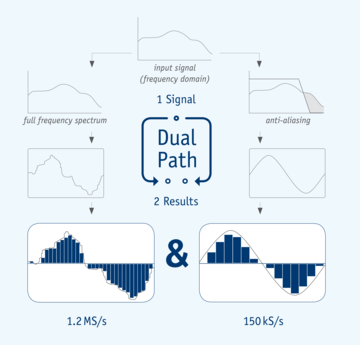DualPath
DualPath – Twice the results, half the time
Your mission: determine the overall efficiency of a drive-motor combination.
In order to achieve your goal, you are eager to find answers to the following questions:
- What percentage of the drive’s output power is ending up at the fundamental frequency of the motor, and thus contributing to torque?
- Do the harmonics comply with your requirements?
- What does output power look like over the entire 10 MHz frequency band?
Let us assume you have an instrument at hand that is up to the job - in principle. Its sampling rate is high enough to deal with PWM frequencies in the kilohertz range. It has sufficient channels to measure all input and output phases simultaneously. It has harmonics analysis built-in. Its analog bandwidth is sufficient to capture all high-frequency by-products. Its precision, especially at higher frequencies, meets your requirements. Still, there is no way for you to obtain all answers in a single test, as some questions are mutually exclusive – at least they used to be under the traditional approach.
When using conventional power analyzers, a choice has to be made before measuring: to filter, or not to filter. If aliasing is a potential concern, filters need to be set to avoid undersampling of higher frequencies, which means wideband values are lost. Without filtering, FFT results become questionable, as there is always the risk of aliasing. An error of 50 % may be easily detected, however a deviation of 0.5 % will go unnoticed. Don’t let yourself get fooled by someone pretending you can simply apply digital filtering after sampling – once aliasing has contaminated your measurements, there is no way (at least no way in accordance with the laws of mathematics & physics!) to get rid of it afterwards.
| So, the only choice is to duplicate all tests: first with, then without filtering - or the other way around; Which is not as easy as it sounds. In order for the tests to be truly repeatable, ALL variables need to be restored to their initial values, which can take quite some time, e.g. in regard to ambient temperature. In order to find a way out of the above dilemma, ZES ZIMMER has fundamentally redesigned signal processing and developed the DualPath architecture. The LMG670 is the first power analyzer to have two A/D converters in two independent signal paths for each current and voltage channel. One for the filterless measurement of the wideband signal, and a second for the narrowband signal at the output of the anti-aliasing filter. The parallel processing of the digitized sample values gives the user access to both measurements of the same signal, without risking aliasing effects. |
|
This unique procedure avoids all of the downsides of previous approaches and guarantees the most precise result in the shortest time possible. The LMG670 gets all necessary values in one shot.

